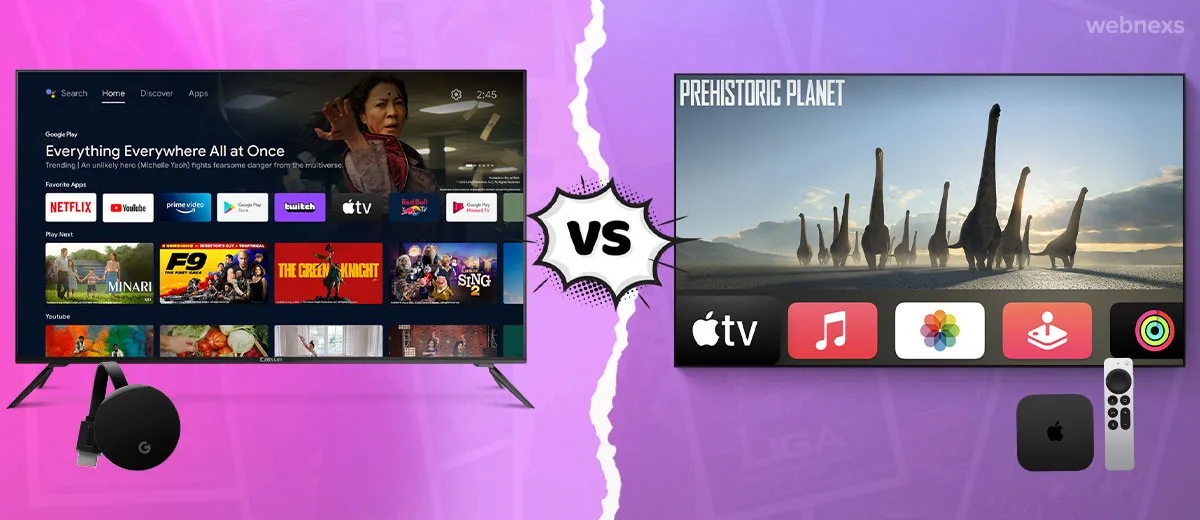In this article, we will compare Chromecast and AirPlay, two popular ways to stream content from your device to your TV. We’ll discuss their Comprehensive Comparison of Chromecast vs airplay
Audio and video streaming technologies, along with wireless communication protocols such as Chromecast and AirPlay, have gained significant popularity in today’s world. While Chromecast is known for streaming content on devices like TVs and other Chromecast-connected screens, AirPlay is famous for allowing users to stream video and audio content on various connected browsers and Apple devices.
If you’re in the streaming business, it’s recommended to support both Chromecast and AirPlay to target both ecosystems. This blog aims to examine the primary distinctions between Chromecast and AirPlay, facilitating a better comprehension of both technologies and enabling you to get started with confidence. So, let’s begin!
What is Chromecast?
Chromecast is a streaming device developed by Google that allows you to stream content from your phone, tablet, or computer to your TV. It’s a small dongle that plugs into your TV’s HDMI port and is controlled by your device.
Chromecast streams Netflix, Hulu, YouTube, and Google Play Movies & TV, among other services. It also supports Google Stadia for gaming and can even mirror your computer screen through Google Chrome.
One of the main advantages of Chromecast is its ease of use. Simply plug it into your TV, connect to your Wi-Fi network, and start streaming from your device. You can use your phone or computer as a remote control to pause, play, and adjust the volume.
- First Generation Chromecast: released in 2013, supported 1080p video streaming, compatible with Android and iOS devices
- Second Generation Chromecast: released in 2015, improved hardware specifications including support for 5GHz Wi-Fi networks and faster processing speeds, introduced Fast Play feature
- Chromecast Ultra: released in 2016, designed to support 4K Ultra HD video streaming and high dynamic range (HDR) content, faster processor than previous models, included Ethernet port
- Third Generation Chromecast: released in 2018, similar design to second generation model, improved hardware specifications such as faster processing speeds and support for 1080p video streaming at 60 frames per second
- Chromecast with Google TV: released in 2020, new design, includes remote control with voice search capabilities, new interface called Google TV that combines content from various streaming services into a single, personalized recommendations page.
What is airplay?
AirPlay is a wireless streaming technology developed by Apple that allows you to stream content from your Apple device to other compatible devices, such as speakers, Apple TV, or smart TVs that support AirPlay.
It enables you to stream music, videos, and photos from your iPhone, iPad, or Mac to your speakers or TV, with support for up to 7.1 surround sound for superior audio quality.
Also allows you to mirror your device’s screen on your TV, making it easy to share presentations or play games with friends and family on a bigger screen.
| AirPlay Compatible Sender Devices | AirPlay Compatible Receiver Devices |
| iPhone | Apple TV |
| iPad | Smart TVs |
| Mac | Speakers |
| iPod touch | Third-party devices with AirPlay support |
| iTunes on Windows | |
| Safari on Mac | |
| QuickTime on Mac |
Chromecast and AirPlay: A Comprehensive Comparison
Audio quality
Both Chromecast and AirPlay support high-quality audio streaming. Chromecast supports up to 5.1 surround sound, while AirPlay supports up to 7.1 surround sound.
For audiophiles, AirPlay’s superior audio quality may be especially appealing. However, for most people, the difference in audio quality between the two is negligible.
Video Quality
With streaming quality, both Chromecast and AirPlay offer high-quality streaming. Chromecast supports up to 1080p HD streaming, while AirPlay supports up to 4K streaming.
However, the quality of your streaming experience will also depend on your internet connection and the content you’re streaming.
Voice Control
Both Chromecast and AirPlay offer voice control through their respective virtual assistants – Google Assistant for Chromecast and Siri for AirPlay. However, Chromecast offers more flexibility in terms of voice control. Chromecast allows you to utilize voice commands to play, pause, stop, skip, and adjust the volume of your streamed media. On the other hand, AirPlay only offers basic voice control for commands like play, pause, and skip.
Ease of use
Both Chromecast and AirPlay are relatively easy to use. Using Chromecast is as simple as plugging it into your TV, setting it up on your device, and initiating casting.AirPlay works similarly, but you’ll need an Apple TV or other compatible device.
One advantage of Chromecast is that you don’t need a separate remote to control it. You can use your phone, tablet, or computer to control playback.
Cost
The cost of Chromecast and AirPlay can vary depending on the specific model you choose. Chromecast devices range from $29.99 to $69.99, while AirPlay devices range from $149 to $179.
If you’re looking for a more affordable option, Chromecast is the way to go. However, if you’re an Apple user, AirPlay may be the more convenient option.
Streaming options
Chromecast and AirPlay both offer a variety of streaming options, including popular streaming services like Netflix, Hulu, and Amazon Prime Video. However, Chromecast also supports Google Play Movies & TV, while AirPlay supports Apple’s iTunes.
If you’re heavily invested in either Google or Apple’s ecosystem, you may find one option more appealing than the other.
Comparison chart Chromecast vs Airplay
Here’s a side-by-side comparison of Chromecast vs AirPlay:
| Feature | Chromecast | AirPlay |
| Compatibility | Android, iOS, Google Chrome | Apple devices |
| Quality | Up to 1080p HD | Up to 4K |
| Ease of use | Easy to use, controlled by phone or computer | Easy to use, requires Apple TV or compatible device |
| Cost | Range from $29.99 to $69.99 | Range from $149 to $179 |
| Streaming options | Google Play Movies & TV, popular streaming services | iTunes, popular streaming services |
| Audio quality | Up to 5.1 surround sound | Up to 7.1 surround sound |
Chromecast vs AirPlay: Market Trends and Growth
Ecosystem
Chromecast and AirPlay are part of different technology ecosystems. Chromecast is part of the Google ecosystem and works best with Android devices and Google services like Google Play, YouTube, and Google Photos. On the other hand, AirPlay is part of the Apple ecosystem and works seamlessly with iOS devices, Macs, and Apple services like Apple Music and iTunes.
Market
Chromecast and AirPlay have both gained significant market share in the streaming media player market. According to a 2021 report by Strategy Analytics, Chromecast was the second best-selling streaming media player worldwide in 2020, with a 15% market share. AirPlay, on the other hand, is included in Apple devices and is not sold as a standalone product, making it difficult to measure its market share.
Growth Scope
Both Chromecast and AirPlay have seen significant growth in recent years. According to a report by Grand View Research, the global streaming media player market is expected to grow at a compound annual growth rate of 13.5% from 2021 to 2028. Chromecast and AirPlay are both well-positioned to benefit from this growth, as they offer consumers an affordable and convenient way to stream content to their TVs and speakers.
Overall, Chromecast and AirPlay are both popular and well-established streaming technologies that are part of different ecosystems but offer similar features and capabilities. Their respective market shares and growth potential will likely depend on factors such as product innovation, user experience, and integration with other services and devices.
Unlock Your Streaming Potential with Webnexs AirPlay and Chromecast Integration
Webnexs is an all-in-one OTT platform provider that allows you to build and expand your own branded OTT app and website with robust support for Chromecast and AirPlay. This enables you to target the respective ecosystems and increase your streaming business profit. Additionally,
Webnexs offers a variety of competitive features, solutions, and perks, such as
- The ability for audiences to watch via connected browsers
- Support for both on-demand and live content
- Easy offline download and playback options
- Mobile app support with Google Cast
- No additional costs are required, and
- Robust support for video ads.
- AirPlay is compatible with all Apple devices, and other features.
Conclusion
With the rising popularity of video streaming platforms such as Netflix and Hulu, the market for streaming dongles like Google Chromecast, Amazon Fire TV, Android TV, and Roku is also expanding. Each of these devices comes with its own set of advantages and disadvantages, making the decision of which one to integrate into your tech ecosystem a challenging task, particularly if you already own a smart TV.
We trust that this article has provided valuable insights to help you navigate the choice between Chromecast and AirPlay, enabling you to select the most suitable device for your home entertainment setup.


